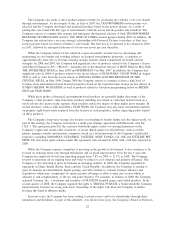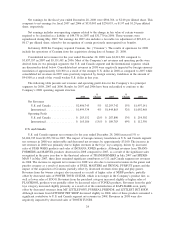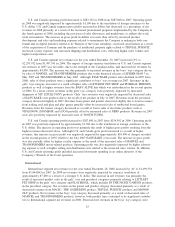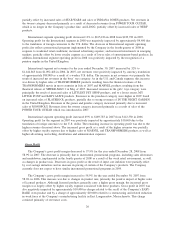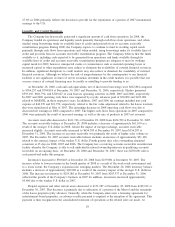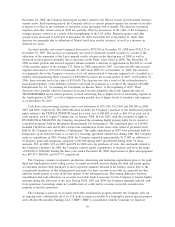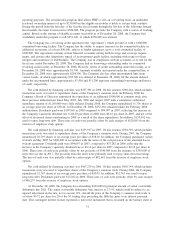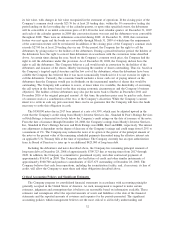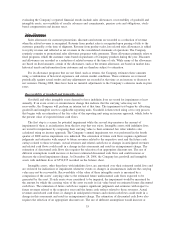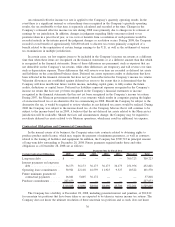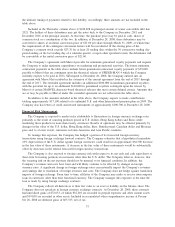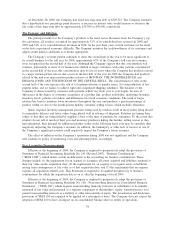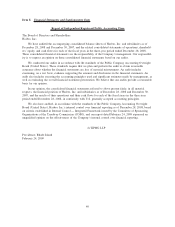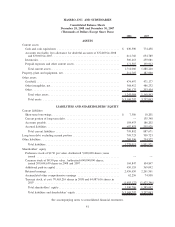Hasbro 2008 Annual Report Download - page 42
Download and view the complete annual report
Please find page 42 of the 2008 Hasbro annual report below. You can navigate through the pages in the report by either clicking on the pages listed below, or by using the keyword search tool below to find specific information within the annual report.
its fair value, with changes in fair value recognized in the statement of operations. If the closing price of the
Company’s common stock exceeds $23.76 for at least 20 trading days, within the 30 consecutive trading day
period ending on the last trading day of the calendar quarter, or upon other specified events, the debentures
will be convertible at an initial conversion price of $21.60 in the next calendar quarter. At December 31, 2007
and each of the calendar quarters in 2008 this conversion feature was met and the debentures were convertible
throughout 2008. There were no debentures converted during 2008. At December 31, 2008, this conversion
feature was met again and the bonds are convertible through March 31, 2009 at which time the requirements
of the conversion feature will be reevaluated. In addition, if the closing price of the Company’s common stock
exceeds $27.00 for at least 20 trading days in any 30 day period, the Company has the right to call the
debentures by giving notice to the holders of the debentures. During a prescribed notice period, the holders of
the debentures have the right to convert their debentures in accordance with the conversion terms described
above. At certain times during the year, based on the Company’s common stock price, the Company had the
right to call the debentures under this provision. As of December 28, 2008, the Company did not have the
right to call the debentures. The Company believes a call would result in conversion by the holders of the
debentures and issuance of the shares, thereby increasing the number of shares outstanding. Thus far, based on
the Company’s targeted capital structure and the low cost of the debentures, when the debentures have been
callable the Company has believed that it was more economically beneficial for it to not exercise its right to
call the debentures. Currently, this economic benefit includes a lower cash cost of paying interest on the
debentures than the Company would pay in dividends on the incremental number of shares that would be
outstanding. The Company will continue to assess, at times when it is available, the desirability of exercising
the call option in the future based on the then existing economic circumstances and the Company’s business
objectives. The holders of these debentures may also put the notes back to Hasbro in December 2011 and
December 2016 at the original principal amount. At that time, the purchase price may be paid in cash, shares
of common stock or a combination of the two, at the Company’s discretion. While the Company’s current
intent is to settle in cash any puts exercised, there can be no guarantee that the Company will have the funds
necessary to settle this obligation in cash.
The $350,000 notes due in 2017 bear interest at a rate of 6.30%, which may be adjusted upward in the
event that the Company’s credit rating from Moody’s Investor Services, Inc., Standard & Poor’s Ratings Services
or Fitch Ratings is decreased two levels below the Company’s credit ratings on the date of issuance of the notes.
From the date of issuance through December 28, 2008, the Company’s ratings from Moody’s Investor Services,
Inc., Standard & Poor’s Ratings Services and Fitch Ratings were BBB, Baa2 and BBB, respectively. The interest
rate adjustment is dependent on the degree of decrease of the Company’s ratings and could range from 0.25% to
a maximum of 2%. The Company may redeem the notes at its option at the greater of the principal amount of
the notes or the present value of the remaining scheduled payments discounted using the effective interest rate
on applicable U.S. Treasury bills at the time of repurchase. The Company currently has an open authorization
from its Board of Directors to issue up to an additional $425,000 of long-term debt.
Including the debentures and notes described above, the Company has remaining principal amounts of
long-term debt at December 28, 2008 of approximately $709,723 due at varying times from 2017 through
2028. In addition, the Company is committed to guaranteed royalty and other contractual payments of
approximately $16,041 in 2009. The Company also had letters of credit and other similar instruments of
approximately $100,700 and purchase commitments of $227,673 outstanding at December 28, 2008. The
Company believes that cash from operations, including the securitization facility, and, if necessary, its line of
credit, will allow the Company to meet these and other obligations described above.
Critical Accounting Policies and Significant Estimates
The Company prepares its consolidated financial statements in accordance with accounting principles
generally accepted in the United States of America. As such, management is required to make certain
estimates, judgments and assumptions that it believes are reasonable based on information available. These
estimates and assumptions affect the reported amounts of assets and liabilities at the date of the financial
statements and the reported amounts of revenues and expenses for the periods presented. The significant
accounting policies which management believes are the most critical to aid in fully understanding and
32


